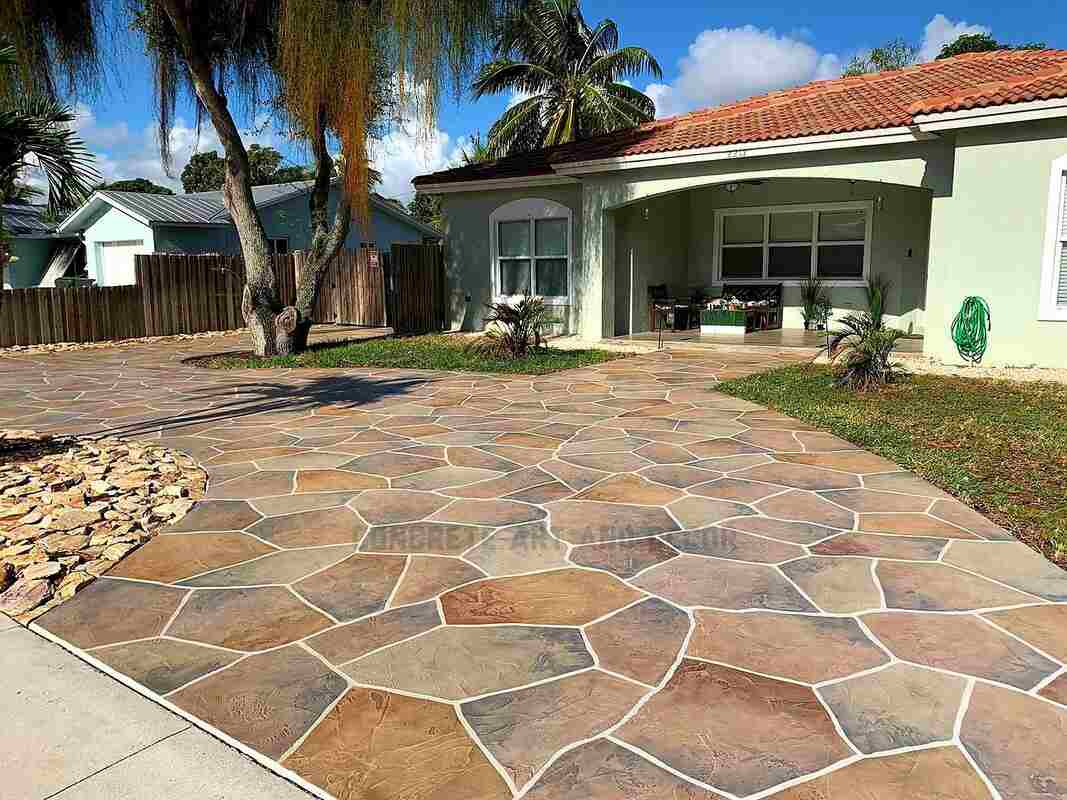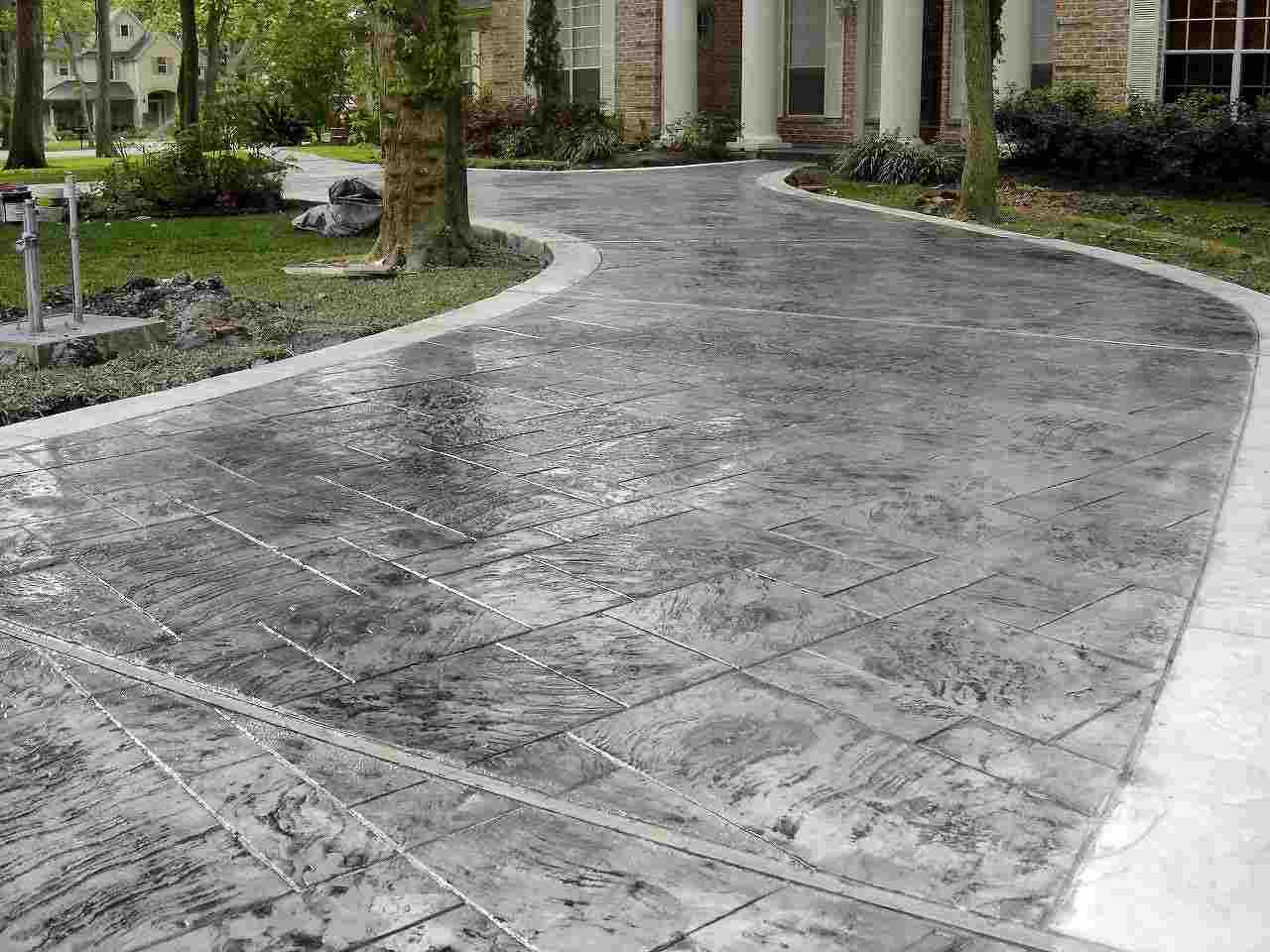Let’s delve into the fascinating world of driveways, particularly stamped and traditional concrete ones. Imagine Liberty Heritage Nursery Farm—a serene place with sprawling driveways. Now, picture stamped concrete driveways there. They’re like artworks, mimicking brick, stone, or tile patterns, adding a touch of elegance. On the other hand, traditional concrete driveways are simpler, smooth, and more straightforward, yet they have their own charm. Whether you prefer the artistic flair of stamped concrete or the classic appeal of traditional concrete, both options have unique characteristics to suit different tastes and styles.
Design Options:
When it comes to design options, stamped concrete driveways offer a wide array of choices that allow homeowners to get creative and personalize their driveways. As mentioned earlier, you can choose from a variety of patterns including brick, stone, tile, wood, and more. Additionally, you can select from a range of colors and finishes to complement your home’s exterior and landscape design.
The process of creating a stamped concrete driveway involves several steps. First, the area is prepared by excavating and compacting the soil to create a stable base. Then, a layer of concrete is poured and leveled to the desired thickness. Next comes the fun part – stamping! Textured mats or molds are pressed onto the wet concrete to imprint the chosen pattern and texture. After the concrete has cured and dried, it is sealed to enhance durability and protect against stains.
Installation Process:
The installation process for stamped and traditional concrete driveways differs mainly in the decorative elements and techniques involved. Stamped concrete driveways require additional steps such as creating patterns, coloring, and stamping, which can make the process slightly more complex and time-consuming compared to traditional concrete.
For stamped concrete driveways, the preparation and pouring stages are similar to traditional concrete driveways. However, once the concrete is poured and leveled, the stamping process begins. This involves carefully placing and pressing textured mats or molds onto the surface to create the desired pattern and texture. It’s essential to work efficiently during this stage to ensure uniformity and proper alignment of the stamped elements.
Maintenance Requirements:

Both stamped and traditional concrete driveways require regular maintenance to ensure their longevity and appearance. However, the specific maintenance tasks and frequency may vary depending on the type of driveway and its exposure to environmental factors.
For stamped concrete driveways, regular maintenance typically includes cleaning, sealing, and occasional resealing. Cleaning can be done using mild soap and water or a specialized concrete cleaner to remove dirt, debris, and stains. Sealing is crucial to protect the stamped surface from moisture penetration, UV exposure, and color fading. It’s recommended to reseal stamped concrete driveways every few years to maintain their durability and aesthetics.
Additionally, homeowners with stamped concrete driveways should avoid using harsh chemicals, de-icing agents containing salts, or abrasive cleaning tools that can damage the surface or affect the sealer’s effectiveness. Proper care and maintenance can significantly extend the life of a stamped concrete driveway and preserve its visual appeal.
Cost Considerations:
For budget-conscious Liberty Township residents, traditional concrete driveways offer cost-effective solutions. They are generally more affordable upfront compared to stamped concrete driveways. If you’re looking for durable and budget-friendly driveway options, consider consulting Budget-Friendly Driveway Solutions. They specialize in providing high-quality traditional concrete driveways that meet your needs and budget constraints. With their expertise, you can have a functional and aesthetically pleasing driveway without breaking the bank.
When considering cost, stamped concrete driveways typically have a higher upfront investment due to the decorative elements involved. On the other hand, traditional concrete driveways are more budget-friendly initially. For cost-effective solutions and quality craftsmanship, Hardscaping Services can help. Their expertise in designing and installing concrete driveways ensures a durable and aesthetically pleasing addition to your property, all while working within your budgetary constraints.
Longevity and Durability:
In terms of longevity and durability, both stamped and traditional concrete driveways can be excellent choices when properly installed and maintained. Stamped concrete driveways, with their added layer of sealant and decorative elements, can last for decades with regular care. The durability of stamped concrete also depends on factors like the quality of materials used, climate conditions, and the expertise of the installer.
Traditional concrete driveways are also known for their durability and can withstand heavy use and environmental factors. With proper installation, curing, and maintenance, a traditional concrete driveway can last for many years. Regular inspections and repairs of any cracks or damage are crucial to ensuring its longevity.
Aesthetic Appeal and Customization:

Aesthetic appeal and customization are significant factors when choosing between stamped and traditional concrete driveways. Stamped concrete offers a wide range of design options, mimicking expensive materials like brick or stone. This versatility makes it ideal for homeowners looking to enhance their property’s curb appeal. For expert advice and professional installation services, consider consulting Driveways and Walkways Services, specializing in creating beautiful and customized concrete surfaces tailored to your preferences.
Additionally, stamped concrete driveways can enhance the curb appeal of a property and create a visually striking entrance. The ability to mimic expensive materials at a fraction of the cost makes stamped concrete a popular choice for homeowners seeking a unique and personalized driveway.
Climate Considerations:
Climate plays a crucial role in the performance and maintenance of both stamped and traditional concrete driveways. In regions with extreme temperatures, freeze-thaw cycles, or frequent exposure to harsh weather conditions, proper installation and maintenance become even more critical.
Stamped concrete driveways, especially those with intricate patterns and textures, may require extra care in climates prone to temperature fluctuations or heavy precipitation. The sealant used on stamped concrete helps protect it from moisture penetration and freeze-thaw damage, but regular inspections and resealing may be necessary to maintain its integrity.
Environmental Impact:
When considering the environmental impact of stamped and traditional concrete driveways, several factors come into play, including material sourcing, installation techniques, and long-term sustainability.
Stamped concrete offers environmental benefits for Liberty Township driveways. It can incorporate recycled materials, reducing waste. Additionally, it mimics natural materials like stone or brick, reducing the need for quarrying. This sustainable approach aligns with environmental goals. For eco-friendly solutions and stunning driveways, consider The Benefits of Stamped Concrete for Liberty Township Driveways. They specialize in creating beautiful, durable, and environmentally conscious concrete surfaces tailored to your needs and preferences.
Traditional concrete driveways, while durable and long-lasting, may have a higher initial environmental impact due to the energy-intensive production of cement and concrete materials. However, advancements in concrete technology and sustainable practices are continuously improving the environmental performance of traditional concrete driveways.
FAQs
What is the difference between regular concrete and stamped concrete?
Regular concrete is plain and smooth, typically used for basic construction purposes like sidewalks and foundations. On the other hand, stamped concrete undergoes a decorative process where patterns and textures are imprinted onto the surface to mimic the appearance of natural materials like brick, stone, or tile. This makes stamped concrete a more visually appealing option for driveways, patios, and other outdoor spaces.
What are the advantages and disadvantages of stamped concrete?
The advantages of stamped concrete include its aesthetic appeal, as it can mimic expensive materials like brick or stone at a lower cost. It also offers durability and low maintenance when properly installed and sealed. However, disadvantages may include the potential for cracking over time, especially in regions with freeze-thaw cycles, and the need for occasional resealing to preserve its appearance and functionality.
What is the difference between stamped and stained concrete?
Stamped concrete involves imprinting patterns and textures onto the surface to mimic the appearance of natural materials like brick or stone. In contrast, stained concrete involves applying color to the surface, enhancing its visual appeal without changing its texture or pattern. While stamped concrete adds texture and depth, stained concrete primarily focuses on enhancing the color and tone of the surface.
What is the difference between stamped and brushed concrete?
Stamped concrete involves imprinting patterns and textures onto the surface to mimic the appearance of natural materials like brick or stone. On the other hand, brushed concrete is achieved by running a broom or brush over the surface during the curing process, creating a textured finish that provides better traction. While stamped concrete adds decorative elements, brushed concrete enhances functionality by improving slip resistance.
What are the disadvantages of stamped concrete?
The disadvantages of stamped concrete include the potential for cracking over time, especially in regions with freeze-thaw cycles or heavy vehicle traffic. Another drawback is that stamped concrete may require periodic resealing to maintain its appearance and durability, adding to the maintenance costs over its lifespan. Additionally, the initial installation cost of stamped concrete can be higher compared to traditional concrete, depending on the complexity of the design and the chosen patterns.
Conclusion:
In conclusion, both stamped and traditional concrete driveways have their unique characteristics, advantages, and considerations. Stamped concrete driveways offer a wide range of design options, aesthetic appeal, and customization possibilities, making them ideal for homeowners seeking a personalized and visually striking driveway. However, they may require more maintenance and have a higher initial cost compared to traditional concrete.
Ultimately, the choice between stamped and traditional concrete driveways depends on your preferences, budget, aesthetic goals, and environmental considerations. Consulting with experienced contractors, evaluating your landscaping needs, and considering long-term maintenance can help you make an informed decision that enhances the beauty and functionality of your property.
